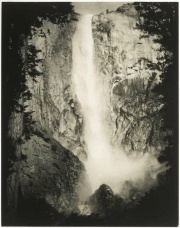Gum bichromate
Revision as of 13:13, 27 April 2013 by (username removed)
Description
A photographic emulsion used in nineteenth century printing processes. Gum printing was invented by Alphonse Poitevin in 1855 and the technique was enhanced by John Pouncy in 1858. Paper is coated with a gum arabic/pigment emulsion that has been sensitized with potassium bichromate. When exposed to light, the bichromated gum hardens proportional to the intensity of radiation. The non-exposed areas remain soft and water-soluble, while the exposed areas become hard and moisture resistant. After exposure, the print is washed to remove the soft gum regions leaving a positive image on the paper. Carbon black was the most commonly used pigment and the prints often resembled charcoal drawings.
Additional Images
Authority
- The Dictionary of Art, Grove's Dictionaries Inc., New York, 1996 Comment: "Photography"

